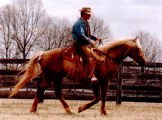Transition to new hay, alfalfa pellet warning...
DOBBIN’S SEASONAL CONCERNS
Winter is the time we usually feed hay as the primary source of roughage. The grass is by now gone (this year for sure), and the horses have little choice but to eat the hay we offer them.
Often, in an attempt to do the best for our horses, we will feed the very best hay on the market. In this area the most popular is the second or later cutting of alfalfa. The hay is often so leafy with so few stems, we are tempted to add the salad dressing of our choice and enjoy it just before dinner. Unfortunately, when fed alone, this high quality hay may be difficult for the horses to digest.
There are two ways to evaluate how well Dobbin is digesting his hay. It really does make some difference how long he has been enjoying this particular offering of hay. If he has been eating it since fall, his digestive system is probably handling it well. If he has been on grass hay or pasture most of the time and is suddenly given the new hay, there may be trouble. The best way to see how well the hay is being digested is to observe his stool. Ideally the stool should be formed into the normal biscuits which break apart when passed. If the hay is too leafy, to high in protein, or there is not enough total roughage in the ration, the stool will be loose with the appearance of a cow pile. It will be soft to runny. If Dobbin is being fed only the good hay, you may catch him eating his bedding whether it be shavings or straw, his own or other horse’s stool, or even eating the stall or wooden fences. These are sure  signs he is not receiving enough roughage to satisfy his digestive tract.
signs he is not receiving enough roughage to satisfy his digestive tract.
To prevent such problems, all you have to do is  introduce him to new hay slowly. You will want to make the transition before the old hay is gone. Feed the old hay first, followed by the new hay. This will fill the horse’s stomach and prevent him from gorging on the new hay when it is offered. When the new hay becomes a major part of his ration, if it is the very good quality we mentioned above, continue to feed some other hay to provide the coarse, long stem roughage. DO NOT depend on alfalfa pellets as the source of roughage. To prepare the pellets, the alfalfa must be ground fine and pressed into the shape of a pellet. This process eliminates the stems. In addition, most of the horses we treat for choke are fed alfalfa pellets alone or with the ration. The pellets expand when wet and may start doing so even before they are swallowed. By the time they are part of the way down the esophagus to the stomach, they will have swelled enough to plug it.
introduce him to new hay slowly. You will want to make the transition before the old hay is gone. Feed the old hay first, followed by the new hay. This will fill the horse’s stomach and prevent him from gorging on the new hay when it is offered. When the new hay becomes a major part of his ration, if it is the very good quality we mentioned above, continue to feed some other hay to provide the coarse, long stem roughage. DO NOT depend on alfalfa pellets as the source of roughage. To prepare the pellets, the alfalfa must be ground fine and pressed into the shape of a pellet. This process eliminates the stems. In addition, most of the horses we treat for choke are fed alfalfa pellets alone or with the ration. The pellets expand when wet and may start doing so even before they are swallowed. By the time they are part of the way down the esophagus to the stomach, they will have swelled enough to plug it.
To summarize, be sure to feed Dobbin enough roughage to keep his stool formed (but not hard). This will also prevent him from eating his bedding, etc. in search of fiber to tickle his stomach.
The good news for the month is that almost every open mare we have examined this year has been cycling. This is unusual for this time of the year. It is often late March or April before their ovaries are enlarged, indicating activity. We have been doing many reproductive exams of open mares in preparation to breeding them. The open mare should be examined for any injuries from past foalings or breedings. If they are cycling, a culture can be taken to ensure there is no infection in the uterus. Infection would prevent live sperm from reaching the meeting point near the ovary and prevent the embryo from implanting once it drops into the uterus. Once the uterus has been found to be clean, the stallion of her choice (or your choice) can be notified and plans made for the mating that will produce the next world beater!
More on this, rabies, and the unusual horse next week.
CLICK BELOW TO DISPLAY A PRINTER-FRIENDLY COPY OF THIS ARTICLE
Select "Open this file from its current location," if you just want to print it out,
it will open in a simple word processing application, select the print button.
(unless you want to save this article in your computer's memory)

 DOBBIN_S_SEASONAL_CONCERNS.rtf
DOBBIN_S_SEASONAL_CONCERNS.rtf